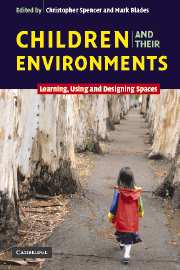Book contents
- Frontmatter
- Contents
- Notes on contributors
- An introduction
- Part I Children's understanding of places
- 1 Scale in children's experience with the environment
- 2 The problem of lost children
- 3 Children's understanding of environmental representations: aerial photographs and model towns
- 4 Children's knowledge of countries
- Part II Children's experience of places
- Part III Adolescents' worlds?
- Part IV Children and the design process
- Index
- References
3 - Children's understanding of environmental representations: aerial photographs and model towns
Published online by Cambridge University Press: 23 October 2009
- Frontmatter
- Contents
- Notes on contributors
- An introduction
- Part I Children's understanding of places
- 1 Scale in children's experience with the environment
- 2 The problem of lost children
- 3 Children's understanding of environmental representations: aerial photographs and model towns
- 4 Children's knowledge of countries
- Part II Children's experience of places
- Part III Adolescents' worlds?
- Part IV Children and the design process
- Index
- References
Summary
We experience the world around us in two ways. By direct experience of living in, travelling through or manipulating our environment, and most of the chapters in this book are concerned with children's and adolescents' direct experience of their environments. But we also learn about the world through secondary sources – for example from spatial representations like maps, from written descriptions, such as guide books, and from visual images like films. These are particularly important sources of knowledge for environments that we have not had the opportunity to experience directly. Compared to the research into children's direct experience and activity in their local environments, there is little research into how children learn about places from secondary sources, and even less into how children combine information from experience and from secondary sources.
In this chapter we will discuss how young children understand one secondary source of information – aerial photographs. In particular we will consider how children relate aerial photographs to real places, in other words how they use photographs to interpret the immediate environment. And we will also consider the reverse issue – what types of environmental experience contribute to children's ability to interpret aerial photographs.
Understanding spatial representations, such as maps, models, and map-like photographs, has at least two functions, for children and adults alike. First, such representations can serve as compact, durable and portable representations of large areas of the world.
- Type
- Chapter
- Information
- Children and their EnvironmentsLearning, Using and Designing Spaces, pp. 42 - 56Publisher: Cambridge University PressPrint publication year: 2006
References
- 7
- Cited by

